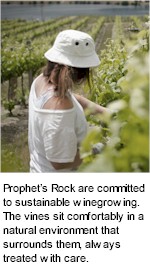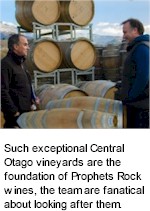


Two vineyards were established in the Bendigo sub-region, Prophet's Rock Home Vineyard and subsequently the Rocky Point. Both are steep and elevated and each is distinctive. The Home Vineyard with its rare mix of soils, including schist, clay and chalk. Rocky Point with its stony ground and almost treacherous slopes. In the winery, they take inspiration from the old houses of Europe. The team refined their trade working in France's classical wine regions, Languedoc and Sancerre, Burgundy and Alsace. Traditionally aesthetic, respectful and patient, vineyard focused. It resonates in the wines and frees them to express the unique tenor of sites.

Prophet's Rock are committed to sustainable wine production. The vines sit comfortably in the natural environment that surrounds them, always treated with care. Prophet's Rock is a member of Sustainable Winegrowing New Zealand. Prophet's Rock produces Pinot Noir, Riesling and Pinot Gris from two estate vineyards in the Bendigo sub-region of Central Otago. Such exceptional vineyards are the foundation of Prophets Rock wines, the team are fanatical about looking after them. The journey starts in the vines, growing harvests of low yielding fruit with great concentration and flavour, fruit that's treated with deference. Harvesting is by hand, everything at the winery is considered.
The Home Vineyard sits on a north-facing terrace high above the Bendigo Station Homestead. With the altitude comes exceptional views, panoramic vistas of the sprawling landscapes beyond the vines, the river terraces of the Cromwell Basin and the stoic mountains of the Pisa Range, shaped by the glaciers that once stood here.
The vineyard hosts a rare mix of soils. Schist and quartz mingle with clay and, notably, a lens of chalk running through the site roughly one metre deep in the soil profile. The alkaline chalk influences nutrient uptake in the vines, while the clay retains water, ideal for keeping the sometimes ornery Pinot grape on side in this cool dry climate.

Perched at the rugged southern end of Bendigo, the Rocky Point Vineyard has some of the steepest planted blocks in Central Otago. The site rises from 226 metres to 351 metres, and walking through the vines one feels the land drop away to the blue waters of Lake Dunstan below. The steep slopes of Rocky Point intercept the sun, while the rough ground, stony free-draining soil littered with shiny broken schist, stores the heat, releasing it overnight when the air temperature drops. Fruit grows and ripens earlier here, crucial in a marginal climate like Central Otago. Rocky Point's shallow soils offer the vines they host a coarse welcome. Vegetation works hard to grow here, but there is reward in the concentrated, deeply rich fruit this struggle produces. Full ripening equals full expression, resulting in wines that know, and show, where they came from.
The region's history looms close too. A lone miner's hut sits on the site, a reminder of the gold rush that gripped the region 150 years ago. Steep slopes, rising from 320 metres to almost 383 metres, capture maximum sun, while the elevation delivers cool nights, encouraging deepened flavour development and freshness in the wines. Kopuwai Delta Vineyard is bounded on one side by New Zealand's largest volume river. The Maori legend for Kopuwai is one of power, and sometimes menace that one would do well to respect given the impressive force of this river.
